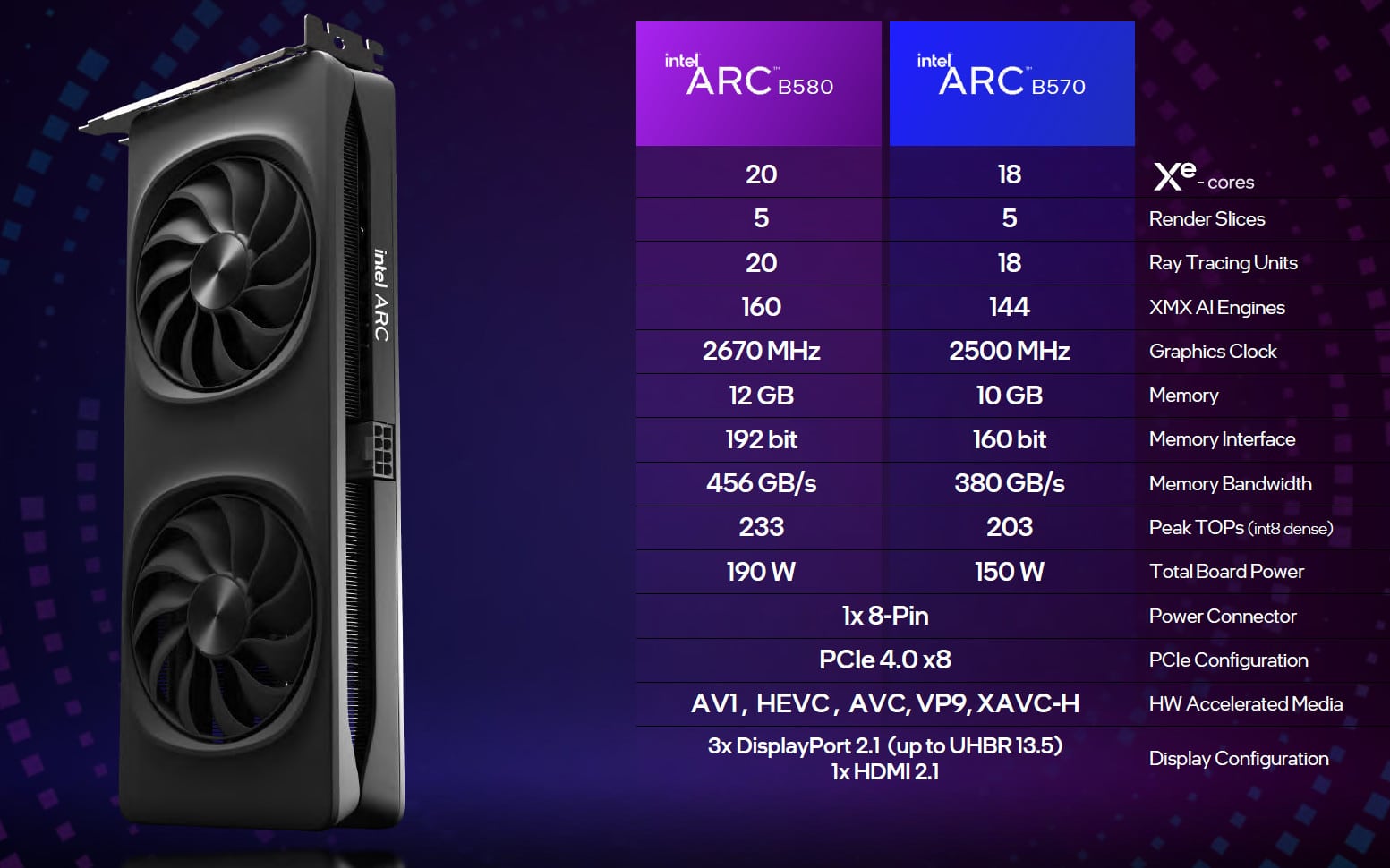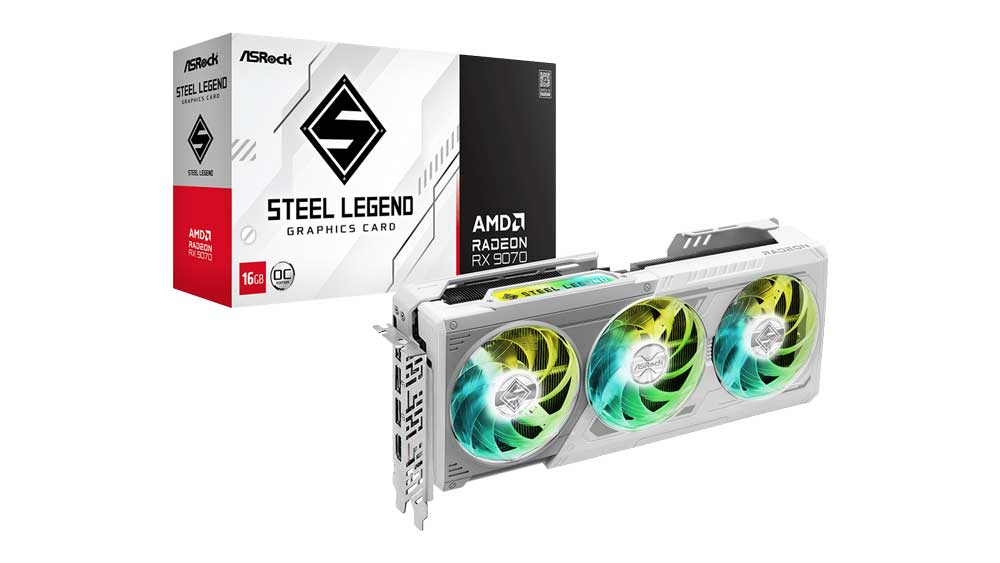Intel has distrupted the affordable GPU category with its Arc Battlemage series and in today’s review I will look at the ASRock Arc B570 Challenger OC which only costs $230, ten dollars more than the MSRP for standard B570 cards, and it is equipped with 10 GB of GDDR6 RAM.
After the initial Arc Battlemage series with the B580, which we haven’t evaluated yet but will soon do, Intel released the more affordable Arc B570. ASRock was kind enough to send us the Arc B570 Challenger OC, sold at 230 dollars, $10 more than the standard B570 designs, with a slight overclock and a custom design. For reference, the B580 cards go for $250, notably lower than NVIDIA’s RTX 4060 offerings, which are pretty popular among gamers who don’t have the crazy amounts that the RTX 5080 and RTX 5090 cost.
The Arc B570 uses Intel’s new Xe2 Battlemage architecture, which is more efficient and performs better than Intel’s previous design (Xe Alchemist). Along with these new GPU designs, Intel also introduced XeSS 2, which introduces XeFG (Freme Generation) and XeLL (Low Latency), besides super-resolution. So, Intel is keeping pace with NVIDIA’s DLSS and AMD’s FSR. The B570 uses the same GPU, BMG-G21, as the B580 based on a 5nm lithography. It has some restrictions: 18 Xe cores instead of 20, and a lower amount of VRAM, 10 GB instead of 12 GB with a narrower bandwidth at 160-bit (192-bit for the B580). Compared to the competing low-end GPUs (RTX 4060 and RX 7600), the B570 has an edge since it offers 2 GB more VRAM and an increased memory bandwidth. In multimedia, the B570 has HDMI 2.1a and DP 2.1 along with AV1 and HEVC encode and decode capable hardware.
The B570’s TDP is low, at 150W, so a plain 6+2 pin PCIe connector is enough for its power needs.
The tables below show the specs of NVIDIA, AMD, and Intel’s recent graphics card models.
NVIDIA Graphics Cards Major Specs
RTX 50 Series
| RTX 5090 | RTX 5080 | RTX 5070 Ti | RTX 5070 | |
| Architecture | GB202 | GB203 | GB203 | GB205 |
| Process Technology | TSMC N4 | TSMC N4 | TSMC N4 | TSMC N4 |
| Base Clock (MHz) | 2010 | 2300 | 2300 | 2160 |
| Boost Clock (MHz) | 2410 | 2620 | 2450 | 2510 |
| VRAM Size (GB) | 32 | 16 | 16 | 12 |
| VRAM Type | GDDR7 | GDDR7 | GDDR7 | GDDR7 |
| VRAM Speed (Gbps) | 28 | 30 | 28 | 28 |
| VRAM Bus Width (bit) | 512 | 256 | 256 | 192 |
| Transistors (Billions) | 92.2 | 45.6 | 45.6 | 31.0 |
| Shading Units | 21760 | 10752 | 8960 | 6144 |
| TMUs/Tensor Cores | 680 | 336 | 280 | 192 |
| ROPs | 176 | 128 | 96 | 64 |
| SM/RT Cores | 170 | 84 | 40 | 48 |
| TDP (W) | 575 | 360 | 300 | 250 |
| Launch Month/Year | 1/2025 | 1/2025 | 1/2025 | 1/2025 |
| MSRP ($) | 2000 | 1000 | 750 | 550 |
RTX 40 Series
| RTX 4090 | RTX 4080 Super | RTX 4070 Ti Super | RTX 4070 Super | RTX 4070 | RTX 4060 Ti | |
| GPU | AD102 | AD103 | AD103 | AD104 | AD104 | AD106 |
| Process Technology | TSMC 5N | TSMC 5N | TSMC 5N | TSMC 5N | TSMC 5N | TSMC 5N |
| Base Clock (MHz) | 2235 | 2295 | 2340 | 1980 | 1920 | 2310 |
| Boost Clock (MHz) | 2520 | 2550 | 2610 | 2475 | 2475 | 2535 |
| VRAM Size (GB) | 24 | 16 | 16 | 12 | 12 | 8 |
| VRAM Type | GDDR6X | GDDR6X | GDDR6X | GDDR6X | GDDR6X | GDDR6 |
| VRAM Speed (Gbps) | 21 | 23 | 21 | 21 | 21 | 18 |
| VRAM Bus Width (bit) | 384 | 256 | 256 | 192 | 192 | 128 |
| Transistors (Billions) | 76.3 | 45.9 | 45.9 | 35.8 | 35.8 | 22.9 |
| Shading Units | 16384 | 10240 | 8448 | 7168 | 5888 | 4352 |
| TMUs/Tensor Cores | 512 | 320 | 264 | 224 | 184 | 136 |
| ROPs | 176 | 112 | 96 | 80 | 64 | 48 |
| SM/RT Cores | 128 | 80 | 66 | 56 | 46 | 34 |
| TDP (W) | 450 | 320 | 285 | 220 | 200 | 160 |
| Launch Month/Year | 9/22 | 1/2024 | 1/24 | 1/24 | 4/23 | 4/23 |
| Street Price ($) | 2500 | 1600 | 915 | 640 | 570 | 399 |
The table below contains the specs of AMD’s current-generation graphics cards for reference purposes.
AMD Graphics Cards Major Specs
| RX 7900 XTX | RX 7900 XT | RX 7900 GRE | Sapphire Radeon RX 7900 GRE | RX 7800 XT | RX 7700 XT | |
| GPU | Navi 31 | Navi 31 | Navi 31 | Navi 31 | Navi 32 | Navi 32 |
| Process Technology | TSMC 5N/6N | TSMC 5N/6N | TSMC 5N/6N | TSMC 5N/6N | TSMC 5N/6N | TSMC 5N/6N |
| Base Clock (MHz) | 1929 | 1387 | 1880 | 1972 | 1295 | 1435 |
| Boost Clock (MHz) | 2498 | 2394 | 2245 | 2333 | 2430 | 2544 |
| VRAM Size (GB) | 24 | 20 | 16 | 16 | 16 | 12 |
| VRAM Type | GDDR6 | GDDR6 | GDDR6 | GDDR6 | GDDR6 | GDDR6 |
| VRAM Speed (Gbps) | 20 | 20 | 18 | 18 | 19.5 | 18 |
| VRAM Bus Width (bit) | 384 | 320 | 256 | 256 | 256 | 192 |
| Transistors (Billions) | 57.7 | 57.7 | 57.7 | 57.7 | 28.1 | 28.1 |
| Shading Units | 6144 | 5376 | 5120 | 5120 | 3840 | 3456 |
| TMUs | 384 | 336 | 320 | 320 | 240 | 216 |
| ROPs | 192 | 192 | 160 | 160 | 96 | 96 |
| Compute Units | 96 | 84 | 80 | 80 | 60 | 54 |
| Ray Tracing Cores | 96 | 84 | 80 | 80 | 60 | 54 |
| TDP (W) | 355 | 300 | 250 | 250 | 263 | 245 |
| Launch Month/Year | 11/22 | 11/22 | 7/23 | 2/24 | 8/23 | 8/23 |
| Street Price ($) | 930 | 750 | 550 | 570 | 500 | 420 |
Intel Graphics Cards Major Specs
| Arc B580 | Arc B570 | |
| GPU (Architecture) | BMG-G21 (Xe2) | BMG-G21 (Xe2) |
| Process Technology | TSMC 5N | TSMC 5N |
| Base Clock (MHz) | 2670 | 2500 |
| Boost Clock (MHz) | 2670 | 2500 |
| VRAM Size (GB) | 12 | 10 |
| VRAM Type | GDDR6 | GDDR6 |
| VRAM Speed (Gbps) | 19 | 19 |
| VRAM Bus Width (bit) | 192 | 160 |
| Transistors (Billions) | 19.6 | 19.6 |
| Shading Units | 2560 | 2304 |
| TMUs/Tensor Cores | 160 | 144 |
| ROPs | 80 | 80 |
| EU/RT Cores | 20 | 18 |
| TDP (W) | 190 | 150 |
| Launch Month/Year | 1/2025 | 1/2025 |
| MSRP ($) | 249 | 219 |
- Cores: 2304
- Core Clock: 2600MHz
- Memory Speed: 19 Gbps
- Standard Memory Config: 10 GB
- Memory Interface Width 160-bit GDDR6
- Memory Bandwidth: 380 GB/sec
- PCI-E 4.0
- Fans: 2x 92mm
- Fan Stop: Yes
- Ports: 3x DisplayPort 2.1, 1x HDMI 2.1a
- Dimensions: 249 * 132 * 41mm, 2-slot
- Weight: 720gr
- Warranty: two years
- MSRP (excluding VAT): $230
- Prologue & Technical specifications
- Intel’s Key Technologies
- Box & Contents
- Part Analysis
- Specifications Comparison
- Test System
- Game Benchmark Details
- Raster Performance
- RT Performance
- RT Performance + DLSS/FSR/XeSS Balanced
- Raytracing Performance + DLSS/FSR/XeSS Balanced + FG
- DLSS/FSR/XeSS Balanced (No RT)
- DLSS/FSR/XeSS Balanced + FG (No RT)
- Relative Perf & Perf Per Watt (Raster)
- Relative Perf & Perf Per Watt (Raster + DLSS/FSR/XeSS)
- Relative Perf & Perf Per Watt (RT)
- Relative Perf & Perf Per Watt (RT + DLSS/FSR/XeSS)
- Relative Perf & Perf Per Watt (RT + DLSS/FSR/XeSS + FG)
- Rendering Performance
- Operating Temperatures
- Operating Noise & Frequency Analysis
- Power Consumption
- Clock Speeds & Overclocking
- Cooling Performance
- Epilogue



